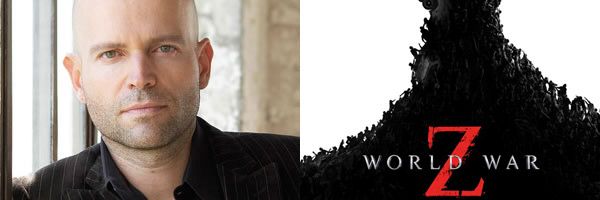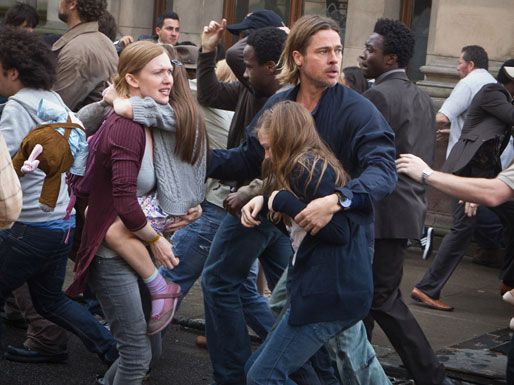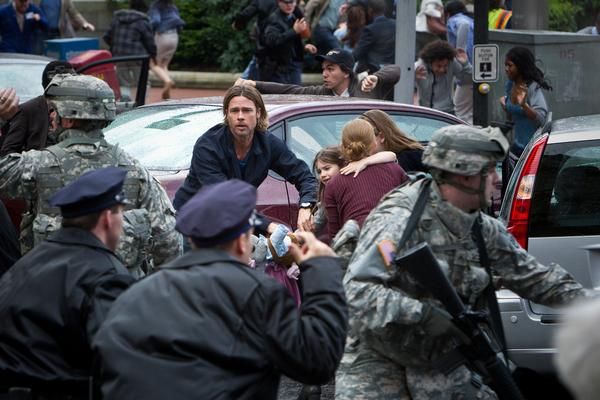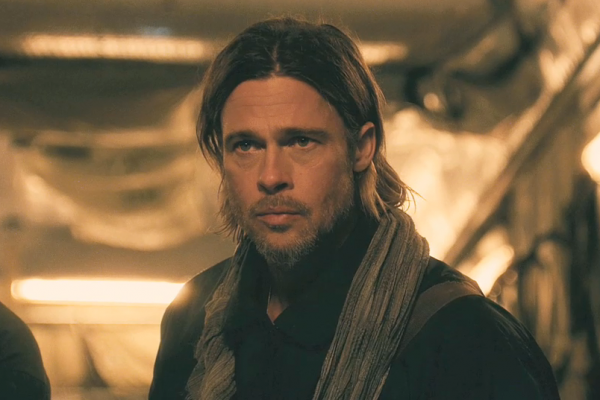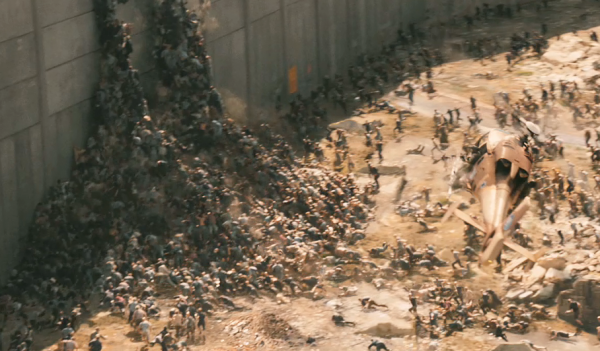With director Marc Forster's World War Z arriving in theaters June 21st, Paramount recently invited a number of reporters to watch about 15 minutes of the movie with an in-person introduction by Brad Pitt. If you haven't seen the latest trailer, Pitt stars as a United Nations employee who traverses the globe in a race to stop a growing Zombie pandemic that threatens to put an end to humanity. The film also stars Mireille Enos, Matthew Fox, James Badge Dale, and David Morse.
As most of you know, I'm not a fan of spoiling a movie, so don't look for a shot-by-shot description of the footage. However, I will say that the footage was loaded with great character moments and kick ass action, took place in various locations around the world, and showcased the main difference between World War Z and other zombie movies: the undead in World War Z move fast and work together to reach a goal. In one of the clips, we watched as a huge hoard of zombies worked together to get over a wall. It was a hell of a sequence that looked great on the big screen. Hit the jump for a lot more.
As I already said, before the footage started, Pitt came into the screening room to talk about making the film, why he wanted to do it, and how he wanted to make something that he could show his kids.
After Pitt's intro and after watching the footage, I was able to participate in a group interview with Forster. During the wide ranging conversation he talked about the process of making the film, the reshoots, the new ending, where he is in the editing process, the zombies, the length of the film, his thoughts on a sequel, and a lot more.
Here are some of the highlights followed by the full interview:
- At the time of the interview, Forster was two weeks away from locking the picture.
- They decided to rewrite and reshoot the ending of the film after looking at the movie all put together.
- There’s a “big difference” between the new ending and the original ending, and Forster prefers the new one as it works in favor of the story.
- When approaching the zombies, Forster saw them as a metaphor about today’s overpopulation and the depleting resources. The idea was that the zombies came out of nature.
- The zombies don’t have superpowers, they just don’t have any cognitive sense of space, height, etc. so the barrel through everything.
- Pitt’s character is a former U.N. employee who is sent on a quest to find patient zero or the root of the problem.
- The film takes place over the course of a couple of days.
- It takes 12 seconds from when a person is bitten to when they become a zombie.
- Forster met with author Max Brooks a couple of times early on to talk about the book, and Brooks gave them his blessing to movie forward. He hasn’t seen the film yet.
- He approached the story in a very real way and wanted everything to feel realistic. In the world of the film, zombie movies exist and characters talk about “zombies.”
- They shot in Malta to double for Israel.
- They incorporated other characters from the book besides just Pitt’s character, like Jurgen Waimbrunn.
- The runtime is around 1:50.
- Forster says there could be more story to tell in a sequel.
- Forster doesn’t consider the movie a zombie film; he considers it a global film about a global crisis.
- There are some child zombies in the movie, but no baby zombies.
Here's the full interview. Look for more on World War Z as we get closer to June 21st.
Question: So, where are you in the editing process right now?
MARC FORSTER: We are about two weeks away from locking picture.
What kind of rules are there for the zombies, I mean, generally head shot will kill them, but here the bullets go anywhere, but they fall, they live. Did you guys have any sort of rules?
FORSTER: No, the rules all say head shots kill them, but if you hit them in the... you know, there’s a line in the movie also, which is not in here, but sort of, “spines are divine, but knees are just fine.” So, just basically, if you hit them in the knees, they start crawling or in the spine and so on, but it’s the same rules. Head shots kill them.
There’s a lot written about changes made to the third act and doing some reshooting of scenes. Sort of talk about what happened and what made it change.
FORSTER: Yeah, I mean, we shot the movie and put it together and we all felt like, we felt the ending wasn’t what we wanted it to be and could be better and we showed it to the studio and us as the filmmakers agreed and made a proposal and they agreed and we went back and did some additional shooting and we are really happy now with the result.
Is it a big difference from the original?
FORSTER: I think towards the ending it’s a big difference, a different ending, yes. I prefer it and it’s always, I think it’s more powerful and really works in the favor of the story.
So many zombie movies and especially stuff like The Walking Dead, we see these hero shots of the zombies, in zombie makeup and sometimes they have personalities that are lent to them, but this it seems like they are more like a force of nature. You don’t give too many identities to these people and the people who are turning into zombies. Do you have those moments or is it more like I said, a force of nature?
FORSTER: No, we do have those moments, but you didn’t see them in this version, but we do have these moments of identity with zombies, one on one as well, later in the film. But, at the same time, the idea was that the zombies came out of nature, sort of this flocking, swarming or sort of George Romero films of the 70’s where the zombies were such a great metaphor for consumerism. For me, the metaphor was more about overpopulation today and less and less resources and this swarming of them is almost like them going after the last resources, especially when the feeding frenzy starts.
So, are they given some sort of superpowers? They seem to jump further, they run faster...
FORSTER: No, no, they don’t have any superpowers.
I meant more so than a regular human, the way they are able to jump and fall.
FORSTER: No, they just, basically don’t know the difference of height and stuff. They just go because they don’t know the building is ending. They just keep moving, wherever they move, they just keep on moving. So, they just don’t know any boundaries.
Ok, so maybe not super, but more enhanced, like speed? I mean, those guys were running pretty fast and bouncing off things...
FORSTER: Yeah, when the feeding frenzy starts, they are more like, they just run, but not faster than any human being.
Can you talk about Brad Pitt’s character and why he has the expertise that they need here?
FORSTER: Yeah, basically Brad Pitt’s character was a U.N. employee and he has, his expertise comes from working in a lot of global places which were in crises, Africa, Bosnia, and so forth and I think you guys saw where the captain sort of gives him his resume and he was able to basically always come out alive out of these places with crises and was able to either identify the problem or the issues at these places and so at this point of the story, it is about to him to find sort of, quote on quote, go on the quest to find patient zero, or find the root of the problem and they feel like he is the right person to assist one of those scientists to find the root of it all.
Could you talk a little about the 3D conversion process?
FORSTER: You know, it’s like, you saw it on the trailer...for me, it was important that still in, like to be able to work in that process and we did a lot of tests and still be able to work in the handheld motion and ultimately when you have faster cuts and the character is more handheld, then sometimes you have to go, you can go less in depth, because your eye doesn’t have to adjust, but I think it’s a fun process and it’s something I would definitely want to explore more and try in the future.
I’m curious what the time frame is in the movie. Is it something that takes place in a few days or over a month or two?
FORSTER: It’s basically a couple of days. It’s pretty compressed.
One of the most common scenes that we see in the zombie genre is when somebody hides their bite and they have that huge moment when you have to decide if you’re going to shoot your loved one. In this film, it looks like it takes about 8 seconds for that conversion to be made. So, I’m curious, what was the motivation behind that?
FORSTER: It’s 12 seconds. We basically discussed, in the film, when you see the entire film, there are some people who turn faster than others, but it’s sort of this idea of how a virus also mutates. We all sort of based in biology, in a sense that some viruses start to mutate very fast and sometimes it takes a bit longer ...like when you saw the countdown in Philadelphia, it takes 12 seconds and then he comes to another place where someone reports that it takes longer, So, he’s trying to figure it out. That’s one of his quests.
How much did Max Brooks have to do with the movie?
FORSTER: Basically, I met Max a couple times when we just spoke about the book and his intentions and I think ultimately, he just gave his blessings. I don’t think, he hasn’t seen the finished film yet, because I want to show it all finished. He has seen some of the material, but I am looking forward to showing it to him. I hope I get his blessings.
Did you get UN advisors to work with you on the accuracy of the film?
FORSTER: If we had some U.N. advisors, you said?
Or CDC.
FORSTER: Yes, yes, we did have some advisors.
In all of the clips I’ve seen of this, including this, Brad Pitt has not been doing any of the killing. Does he get involved in the killing at some point?
FORSTER: Yes. Yes. [Laughter]
And how many zombie actors did you use?
FORSTER: We used, sometimes, it depends, sometimes up to a hundred zombie actors to have like and in some of the crowd scenes, like 50 with excellent makeup up at front and 50 with, you know, sort of a B-group with, where they’re sort of background, but usually 100 people, because it takes a long time in makeup. Sometimes people have to be there at 3am for us to be ready to shoot at 8 or 9.
The woman that plays the wife of Brad Pitt, will she have a bigger role, than kind of the helpless wife?
FORSTER: Yes, she is like basically, she is stuck on the ship when he leaves, but we’re always coming back to her, but I wouldn’t call her the helpless wife. I don’t think that’s the definition.
I saw her kick the zombie in the face in the beginning, so I figured...
FORSTER: No, she gets more active as well.
Quantum of Solace was a pretty big movie and this one looks like way, way bigger. What kinds of challenges does that present?
FORSTER: It’s a very different thing. In Quantum, you’re dealing with a genre, it was a film that has existed over many years and here you’re dealing with a genre which has been done many times, but you’re trying to find a way in that’s still new and fresh and different, that you don’t repeat what other people have done and have a new perspective to it and I think in this one, what was really great about this film is it’s a global epidemic. You can make a global film, which affects so many countries and affects sort of this worldwide epidemic, but it has, zombies are great metaphors for the times we live in today and that’s what I always find fascinating about them, but then it’s like the walking dead, you know, the unconscious, and the metaphors for them are just really something I was inspired by.
What did Brad bring to the role and how did you work with him to kind of craft the character and his viewpoint?
FORSTER: You know, Brad and his company, Plan B, bought the book and developed a screenplay before I got involved and he was always very hands on in developing it and working with it and he’s an iconic movie star who has made such smart choices throughout his career and has such amazing tastes and for me it was really a fantastic collaboration working with him because we share a lot of similar sensitives and developing this was just incredible, a lot of fun, because I never worked with an actor who was also a producer and it worked out really, really positively and so I enjoyed the process tremendously.
The book has a reputation for being more reflective and everything we’ve seen here, seems pretty brisk and fast. Does the movie ever sort of take a break to absorb more of those elements of the book?
FORSTER: Yes, it does take a break and become more reflective. It’s not what you guys saw here.
Sort of along the same point of trying to break out of the zombies and do something original, how are you able to use the public perceptions of zombies as a sort of starting point, where you don’t have to say, “Well this is what zombies are and this is how they work.”
FORSTER: I think in every, when you tell your story, you have to sort of still... I think there are all different kinds of zombies and lots of people who prefer slow zombies versus fast zombies and vice versa and so on. So, I think there’s a whole debate there and as you will see in our film, how the story unfolds, that there is, you can get a taste of both, but you have to see the entire piece.
So, one of the most popular TV shows right now is The Walking Dead, which is extremely violent. Are you concerned that going for a PG-13 is going to make it a little tame compared to what people expect from weekly TV viewing of zombies?
FORSTER: No, because our zombies are... we approach them in a different way and so, I’m not... I consciously designed the film in that way and so I think we will overcome that.
Given the length of the production process, having to rewrite, reshoot, and all of that kind of that stuff, I’m just curious, how do you kind of keep it fresh for yourself?
FORSTER: No, I think you’re always, me at least, I always try to stay objective, and to remove myself from the process and look at the film again and I must say it was really refreshing and actually a great thing that we redid the ending, because I must say I never did that with any of my other movies so far, but I realized that a lot of the great directors that I admire from [Ingmar] Bergman to [Fredrico] Fellini re always shooting, then going into the editing room, and shooting again. Sort of this process back and forth and I think that was a really great thing that we were able to do that and that the studio allowed us to do that, because I think it made the movie better and I think that sort of gave us a different reflection of it, because when you’re really in it and sometimes doing it, sometimes it gets so overwhelming that you might, for a moment, have to take a step back and see, oh what did I do and see how it feels altogether.
It seems like some of the more modern zombie movies have shied away from the actual term, the ‘z’ word. Are you trying to... Is there a challenge to reclaim the word and avoid the sort of campy aspects to what we think of?
FORSTER: Yeah, I mean, the idea is that how I conceived the film, but how I felt the book was as well is that the film should feel very real, that the world, that it could happen right now in the world we live in and to make it as real as possible and sort of create that, because I didn’t want it to feel camp. I wanted it to feel very real, that it could happen actually to us today.
So, to that end, are there zombie movies in this world?
FORSTER: Yes, I think in this world, there were definitely zombie movies and there were actually characters in the film that talk about zombies as well.
Back to the other question, this is going to be PG-13, so you have to avoid blood and gore, I know there’s like the hand cut-off...
FORSTER: But most of the gore and blood, when you see the whole movie, I avoid it on purpose, intentionally.
This is just for my own pure personal curiosity. I love the shot of the zombies climbing up the wall. I think that’s a great new money shot injected into the pantheon of zombie movies we’ve never seen before. Tell me there are more surprises for us.
FORSTER: Yes, I think there are more surprises.
[Group laughter]
FORSTER: But, if I spoiled them, then there’s no more surprises.
Well, the airplane in there...
FORSTER: You saw in the new trailer, they put the airplane in there. That was not a surprise, but there are a few more left. You haven’t seen that in a zombie movie before, outbreak on an airplane.
That wasn’t the Israeli soldier with the hand off?
FORSTER: Sorry?
The infected person on the plane. Was that the Israeli soldier with the hand off?
FORSTER: No, no. It was a different zombie.
What were some of the locations you shot in for the film? Did you actually go to Israel?
FORSTER: No, we shot in Malta for Israel. I went to Israel for casting purposes and went to Jerusalem a couple times, but we were shooting in Malta.
I’m curious about the hero, he’s racing around the world and he’s trying to stay alive and one step ahead of the zombies. I’m wondering does communication break down at some point…
FORSTER: Yes, there will be a communication breakdown, yes. [Group Laughter] It’s the next step, yes.
You mention that the film takes place over the course of a few days. Do we start seeing the breakdown of electricity and the infrastructure as the picture goes on?
FORSTER: Yes, there is a breakdown of infrastructure. I mean some of it is still working and some is breaking down, but yes, you will see that.
As far as how the footage we just saw plays out, is most of it from the first two acts or is there anything from the third act in there?
FORSTER: No, you didn’t see anything. I mean sort of the plane going down is sort of part of the third act.
Obviously, adapting Max Brooks’ book is next to impossible because of all of the stories, but for fans of the book, as they’re watching the movie, are there going to be characters or mentions or nods to stories that are in the book?
FORSTER: Yes, like, for instance the Israeli characters, Jurgen Waimbrunn he is a character and a couple other mentions we have. We tried to incorporate from the book.
What run time are you shooting for?
FORSTER: It’ll probably be a little short of two hours, 1:50 or something like that.
Brad has been quoted in the past as saying he’d like to see a World War Z trilogy. Is that to say this ends on a good note? Is there more story to tell?
FORSTER: Definitely, there could be more story to tell, yes.
Are you worried that zombie fans won’t embrace this film especially as it has more reflective periods in addition to the action?
FORSTER: You know, there are some more reflective moments from the film, but you can’t, some zombie fans you will not be able to make happy and some zombie fans will embrace it and will love the movie. I think there always be discussion and a little bit of controversy, I think, on every zombie movie, because there are definitely different camps of what people prefer or not. I hope that most of the zombie fans will appreciate all the new things we added to the movie that they haven’t seen before in this particular genre.
Do you watch Walking Dead?
FORSTER: Yes.
Have you seen Warm Bodies or Zombieland?
FORSTER: I saw Zombieland. I’ve seen pretty much all of the zombie movies. I haven’t seen Warm Bodies yet, because it just came out, but I still want to see that.
Are you hoping to bring a new audience because the movie is less gory and not everyone is a zombie fan?
FORSTER: For me, this is not just a zombie film. It’s more than that. It’s a global film. It’s a film about a global crisis and I think it’s sort of, in that sense... I just don’t see it. Yes, it’s a zombie film, but it also speaks about some global issues, more to that. So I think in that sense, I feel it might bring in a different audience, hopefully, as well.
I was hoping you could talk a little bit more about the tone of, I mean obviously it’s very dramatic and there’s a lot of action, but are there sort of lighter moments as well?
FORSTER: Yeah, here and there, sprinkled through them, but most of it is a pretty intense ride, like on the edge of your seat, pretty much from beginning to end. Even the more reflective moments, when it gets quiet, it’s like them the tension comes from somewhere else.
One of the things we saw in the footage, which we don’t usually see in Hollywood blockbusters, was the male hero in the corner while the female had a machine gun blowing people away. So, in addition to this sort of global scale, is gender equity part of the whole aesthetic in the film?
FORSTER: Yeah, the great thing is that Brad’s character, Gerry Lane, is sort of the every man’s hero, sort of the anti-hero in that sense. Ultimately, he’s not going to kill unless he’s forced to and when he’s suddenly in that situation with a zombie where he has no choice, but he’s not your typical hero in that sense.
Have you done test screenings and what have you learned from them?
FORSTER: That the audience really embraced the film. We did one and they just really loved the movie and it really went well and everybody was very excited. It seemed like the people who read the book were supportive of the film in that audience and people who were zombie fans thought there were so many new things that they haven’t seen in zombie movies and so it was a very successful screening.
Brad had said that he wanted to make a movie for his kids. Did you bring them in during process, look at the dailies?
FORSTER: No, no. Well, maybe he showed them the dailies. I’m not sure. They came and visited on the set, for sure, but I don’t know how much he let them in on the process. I’m not exactly sure.
Do you have any child zombies? Were they extras ever?
FORSTER: Yes, we had some extras, child zombies.
You have baby zombies?
FORSTER: No baby zombies.

